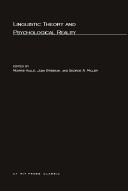Linguistic Theory and Psychological Reality (MIT Bicentennial studies)

Buy online ($)
Type
Book
Authors
ISBN 10
0262080958
ISBN 13
9780262080958
Category
Unknown
[ Browse Items ]
Publication Year
1978
Publisher
Pages
368
Description
"Any adequate psychology of man must provide some way to understand the human capacity for language," the editors of this volume write. "It was a belief shared by quite a few among us that developments in linguistics and psychology were leading to similar conclusions by separate routes and that this was an appropriate time to explore the implications of these apparently parallel developments for future, perhaps joint, work. This volume represents a few initial steps in the direction of that goal." The nine chapters of this book were written by linguists and psychologists, after extended collaboration and exchange of ideas. In the first chapter, "A Realistic Transformational Grammar," Joan Bresnan (MIT) explores some of the consequences of her proposal that the role of many transformations in generative grammar should be subsumed by the lexical component. The character of lexical entries is the central topic of "Semantic Relations Among Words," by George A. Miller (Rockefeller University); he reports views and suggestions that he has developed since the publication of his and Johnson-Laird's monumental Language and Perception (1976). The chapter by Eric Wanner (Rockefeller University) and Michael Maratsos (University of Minnesota), "An ATN Approach to Comprehension," presents a nontransformational model of language processing that uses concepts developed in automatic parsing systems. The relations between their psychological model and Bresnan's lexical-transformational model is outlined in Chapter 1. "Anaphora as an Approach to Pragmatics" by Keith Stenning (University of Liverpool) explores the central problem of pragmatics: a sentence can express different meanings in different contexts. He proposes that a successful account of antecedent-anaphor relations must recognize the relation between a linguistic entity and its context, linguistic or nonlinguistic. Ray Jackendoff (Brandeis), in "Grammar as Evidence for Conceptual Structure," attempts to use the information about semantic structure that is provided by the interpretation of various syntactic configurations in order to gain insights into basic attributes of human cognition. The remaining chapters deal with ways knowledge of a language is acquired and lost. In "Language and the Brain," Edgar B. Zurif (Boston University Medical School) and Sheila E. Blumstein (Brown University and Boston University Medical School) survey some recent work on aphasia in the light of different theoretical models of language. Michael Maratsos, in "New Models in Linguistics and Language Acquisition," inquires into the implications that a language model with restricted transformational component has for understanding of the way children acquire syntax. In "The Child as Word Learner" Susan Carey (MIT) examines the rapidity with which children learn words; she proposes that the process involves two stages: an almost instantaneous assignment of a new world to a field of related words, followed by a slow working out of its place in that field. Finally, Morris Halle (MIT), in "Knowledge Unlearned and Untaught: What speakers know about the sounds of their language," cites facts that normal speakers of English demonstrably know but could never have been explicitly taught, nor in some cases even learned. Halle suggests this is a manifestation of innate knowledge that is genetically programmed into organisms. - from Amzon
Number of Copies
1
| Library | Accession No | Call No | Copy No | Edition | Location | Availability |
|---|---|---|---|---|---|---|
| Main | 10 | 1 | Yes |